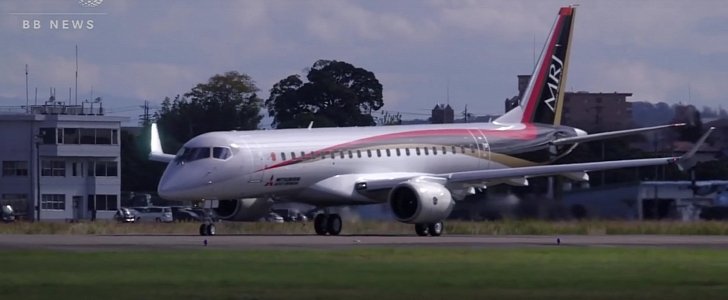It’s been quite the race between aviation-aspiring players to prove they’re back on track. First, China unleashed their narrow-body jet capable of seating 168 passengers, and now, Japan showed they’re back in business. Developed by Mitsubishi Heavy Industries and Toyota Motor Corporation, the MRJ is a twin-engine regional jet aircraft seating 70-90 passengers.
With this flight, the Land of the Rising Sun has fulfilled a dream the country has been working on for more than 40 years. The Mitsubishi Regional Jet is the first airliner designed and produced by Japan since the NAMC YS-11 of the 1960s, which, by the way, was produced at a loss. Fellow transportation enthusiasts, this is big.
Formally called the maiden flight, the jet took off from Nagoya Airport yesterday, thus confirming its fundamental characteristics and functionality in ascent, descent and turning in airspace off the Pacific coast. The MRJ flew for 1.5 hours as the Japanese companies have declared the next-generation aircraft a success.
“The MRJ successfully took to the sky today thanks to ongoing cooperation and support from all members involved,” said Hiromichi Morimoto, President of Mitsubishi Aircraft Corporation. “We will make our utmost efforts towards type certificate acquisition, committing all our resources to develop and produce the finest regional jet aircraft to enter commercial service in 2017.”
The Japanese companies involved in the project have announced they will continue to conduct flight tests for the first delivery scheduled for the second quarter of 2017. As to the US, first flight tests should start in the second quarter of 2016, from the MRJ base at Grant County International Airport at Moses Lake in Washington.
According to AFP, the two-engine MRJ is approximately 35 meters (115 feet) long, has a pointed nose, and will seat about 80 passengers. Mitsubishi Aircraft claims it’s fuel-efficient while operating will lower costs, and it should conquer the regional jet sector once it hits the market. The company’s plan seems to be working so far, considering it has already reported more than 400 orders.
Formally called the maiden flight, the jet took off from Nagoya Airport yesterday, thus confirming its fundamental characteristics and functionality in ascent, descent and turning in airspace off the Pacific coast. The MRJ flew for 1.5 hours as the Japanese companies have declared the next-generation aircraft a success.
“The MRJ successfully took to the sky today thanks to ongoing cooperation and support from all members involved,” said Hiromichi Morimoto, President of Mitsubishi Aircraft Corporation. “We will make our utmost efforts towards type certificate acquisition, committing all our resources to develop and produce the finest regional jet aircraft to enter commercial service in 2017.”
The Japanese companies involved in the project have announced they will continue to conduct flight tests for the first delivery scheduled for the second quarter of 2017. As to the US, first flight tests should start in the second quarter of 2016, from the MRJ base at Grant County International Airport at Moses Lake in Washington.
According to AFP, the two-engine MRJ is approximately 35 meters (115 feet) long, has a pointed nose, and will seat about 80 passengers. Mitsubishi Aircraft claims it’s fuel-efficient while operating will lower costs, and it should conquer the regional jet sector once it hits the market. The company’s plan seems to be working so far, considering it has already reported more than 400 orders.

